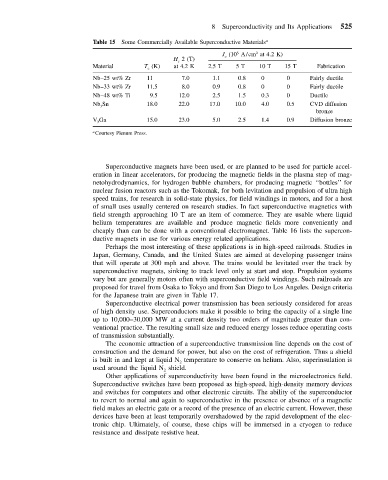Page 536 - Mechanical Engineers' Handbook (Volume 4)
P. 536
8 Superconductivity and Its Applications 525
Table 15 Some Commercially Available Superconductive Materials a
2
5
J c (10 A/cm at 4.2 K)
H c 2 (T)
Material T c (K) at 4.2 K 2.5 T 5 T 10 T 15 T Fabrication
Nb–25 wt% Zr 11 7.0 1.1 0.8 0 0 Fairly ductile
Nb–33 wt% Zr 11.5 8.0 0.9 0.8 0 0 Fairly ductile
Nb–48 wt% Ti 9.5 12.0 2.5 1.5 0.3 0 Ductile
Nb 3 Sn 18.0 22.0 17.0 10.0 4.0 0.5 CVD diffusion
bronze
V 3 Ga 15.0 23.0 5.0 2.5 1.4 0.9 Diffusion bronze
a
Courtesy Plenum Press.
Superconductive magnets have been used, or are planned to be used for particle accel-
eration in linear accelerators, for producing the magnetic fields in the plasma step of mag-
netohydrodynamics, for hydrogen bubble chambers, for producing magnetic ‘‘bottles’’ for
nuclear fusion reactors such as the Tokomak, for both levitation and propulsion of ultra high
speed trains, for research in solid-state physics, for field windings in motors, and for a host
of small uses usually centered on research studies. In fact superconductive magnetics with
field strength approaching 10 T are an item of commerce. They are usable where liquid
helium temperatures are available and produce magnetic fields more conveniently and
cheaply than can be done with a conventional electromagnet. Table 16 lists the supercon-
ductive magnets in use for various energy related applications.
Perhaps the most interesting of these applications is in high-speed railroads. Studies in
Japan, Germany, Canada, and the United States are aimed at developing passenger trains
that will operate at 300 mph and above. The trains would be levitated over the track by
superconductive magnets, sinking to track level only at start and stop. Propulsion systems
vary but are generally motors often with superconductive field windings. Such railroads are
proposed for travel from Osaka to Tokyo and from San Diego to Los Angeles. Design criteria
for the Japanese train are given in Table 17.
Superconductive electrical power transmission has been seriously considered for areas
of high density use. Superconductors make it possible to bring the capacity of a single line
up to 10,000–30,000 MW at a current density two orders of magnitude greater than con-
ventional practice. The resulting small size and reduced energy losses reduce operating costs
of transmission substantially.
The economic attraction of a superconductive transmission line depends on the cost of
construction and the demand for power, but also on the cost of refrigeration. Thus a shield
temperature to conserve on helium. Also, superinsulation is
is built in and kept at liquid N 2
shield.
used around the liquid N 2
Other applications of superconductivity have been found in the microelectronics field.
Superconductive switches have been proposed as high-speed, high-density memory devices
and switches for computers and other electronic circuits. The ability of the superconductor
to revert to normal and again to superconductive in the presence or absence of a magnetic
field makes an electric gate or a record of the presence of an electric current. However, these
devices have been at least temporarily overshadowed by the rapid development of the elec-
tronic chip. Ultimately, of course, these chips will be immersed in a cryogen to reduce
resistance and dissipate resistive heat.

